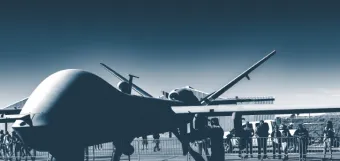Regulating and Limiting the Proliferation of Armed Drones: Norms and Challenges

Regulating and Limiting the Proliferation of Armed Drones: Norms and Challenges
THE WORLD’S ATTENTION HAS BEEN DRAWN IN RECENT MONTHS TO A NUMBER OF SPECTACULAR CASES OF THE USE OF ARMED DRONES IN MILITARY OPERATIONS:
- the targeted killing by the United States of Gen. Qasem Soleimani, the head of the Iranian Qods paramilitary force, at Baghdad airport on 3 January 2020, together with pro-Iranian militia leaders;2
- strikes on Saudi Arabia’s Aramco oil facilities at Abqaiq on 14 September 2019 by some 25 drones and missiles. The Houthi movement in Yemen claimed to have carried out these strikes, but the United States and Saudi Arabia attributed the attack to Iran, which denied responsibility;3 and
- reports that Turkey had made intensive use of armed drones in Syria to destroy dozens of Syrian battle tanks, infantry fighting vehicles, and air defence systems after several of its own drones had been shot down by Syrian or Russian forces in early 2020.4 Previously, Turkey had publicised its manufacture of a new drone, the Songar, armed with a machine gun or grenade launcher, controlled by artificial intelligence, and capable of being used in swarms.5
These events are only the visible part of a global phenomenon that started a few decades ago but is now widespread: the resort to uncrewed air vehicles (UAVs) equipped with weapons as a substitute for air strikes previously carried out by crewed aircraft. As a consequence of the attractiveness of the use of drones – for obvious reasons of cost and pilot safety – the international market in armed drones is booming, creating risks of widespread proliferation, especially to non-state actors or states known for their lack of respect for the laws of warfare.This paper analyses these proliferation risks and formulates recommendations on how to mitigate them.
Starting in the late 20th century, the growth of guided-missile technologyled the international community to draw up political and legal rules in order to control the export of such sensitive equipment – subsequently including UAVs – to countries where the risk of uncontrolled and/or illicit proliferation and use is the highest. The first such attempt was the Missile Technology Control Regime (MTCR), which was established in 1987 to harmonise policies for the export of missiles and related technology and has been gradually extended to cover UAVs. The second regime was a voluntary transparency measure, the United Nations Register of Conventional Arms (UNROCA),
established in 1991, to which UN member states are encouraged to report their exports and imports of conventional arms, including UAVs. The third was the Wassenaar Arrangement, launched in 1996 as a multilateral export control regime for conventional and dual-use goods and technologies, to which UAVs were added. The most recent initiative is the ATT, which entered into force in 2014 and regulates transfers of conventional arms, including certain categories of UAVs. As we will see in section 2, however, these regimes are far from being universal and all have limitations that make it difficult to impose constraints on UAV exports.
Cholpon Orozobekova is a researcher at the Bulan Institute for Peace Innovations in Geneva and GCSP alumna of the International Training Course in Security Policy 2014 as well as New Issues in Security Course 2016. Her research has focused on terrorism, religious extremism and proliferation and regulation of armed drones. Before joining the Bulan Institute, Cholpon worked as a Central Asia Analyst and UN Correspondent. Her analytical articles have been published in such international publications as The Diplomat, Asia Times, and Jamestown Foundation. She also worked in international organizations in Geneva. She holds three MA degrees from Geneva-based universities.
Marc Finaud is the Head of Arms Proliferation at the GCSP. He is a former French diplomat with extensive experience in arms control, non-proliferation and disarmament. In 2013-2015 he also worked as senior resident fellow at the United Nations Institute for Disarmament Research.
